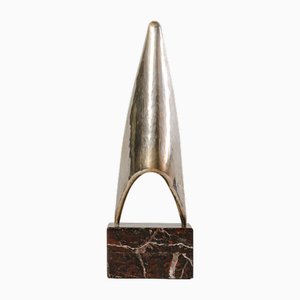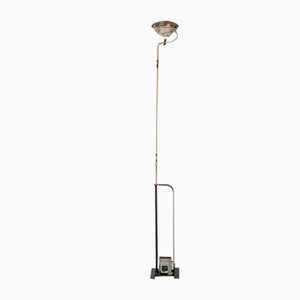The ceramist and designer Pompeo Pianezzola was born in Nove, Vicenza, in 1925 and began his career as a very young ceramist working as an apprentice at the "Antonibon-Barettoni" ceramic factory and studying at the local Art Institute.
Later he attended the Academy of Fine Arts in Venice.
Since the early years of his activity he has been concerned with combining the quality of his work with the need for industrial production, obtaining, starting from the end of the 1940s, the first recognitions both in Italy and abroad.
In 1939 he joined the "Antonibon Barettoni" with the qualification of decorator
He taught at the Art Institute of Nove from 1945 to 1977, assuming its direction in the years 1963-1968.
In 1949 he was given the opportunity to open his own painting studio at "Barettoni".
In the fifties he met the artistic world and participated with important painters in painting and ceramic exhibitions in Italy and abroad.
In 1953 he was invited by the Artists of Figurative Arts association to the XXIII Art Exhibition at the Basilica Palladiana in Vicenza.
In 1957 he opened his own factory, in via Molini 77 in Nove, where he made both artistic and commercial productions and at the same time collaborated as a designer with the Treviso ceramic manufacturer "Appiani" and "Zanolli & Sebellin" in Nove.
Antonio Lucietti and Ico Parisi collaborate with Pianezzola.
In the 1960s, his works lost the figurative aspect to take on an increasingly informal tone.
In 1962 he ranked first in the Gualdo Tadino competition and in 1963 he won the Faenza Prize, with a large gold-on-black shield.
In these same years he created some decorations for dishes inspired by the paintings of Tiepolo and Guardi and produced by the Novese manufacture "Antonibon"
He is first at the Saie in Bologna in the 1968 and 1970 editions and at the International Ceramics in Nagoya, Japan, in 1974.
In 1963, after winning the Faenza Prize, he retired from the actual production activity and was appointed director of the Art Institute of Nove.
In these years he abandoned ceramics to create sculptures in acrylic glass, metal and glass but in '74, returning to his old love, he participated in the II International Symposium of Ceramics in Nove and in 1978 he took part in the first exhibition "Venetian ceramic sculptors"
For a few years he left ceramics again until 1992 when he took part in the Mulhouse exhibition at the Maison de la Ceramique and presented the solo show "Ceramica, sentimento del Tempo" in Beijing.
Pompeo Pianezzola died in Angarano in 2012
Der Keramiker und Designer Pompeo Pianezzola wurde 1925 in Nove (Vicenza) geboren und begann seine Karriere als junger Keramiker mit einer Lehre in der Keramikfabrik "Antonibon-Barettoni" und einem Studium am örtlichen Kunstinstitut.
Später besuchte er die Akademie der Schönen Künste in Venedig.
Seit den ersten Jahren seiner Tätigkeit war er bestrebt, die Qualität seiner Arbeit mit den Erfordernissen der industriellen Produktion zu verbinden, und erhielt ab Ende der 1940er Jahre die ersten Anerkennungen sowohl in Italien als auch im Ausland.
1939 trat er mit der Qualifikation eines Dekorateurs in die Firma "Antonibon Barettoni" ein
Von 1945 bis 1977 lehrte er am Kunstinstitut von Nove, dessen Leitung er in den Jahren 1963-1968 übernahm.
1949 erhielt er die Möglichkeit, sein eigenes Malatelier bei "Barettoni" zu eröffnen.
In den fünfziger Jahren lernte er die Kunstwelt kennen und nahm mit bedeutenden Malern an Malerei- und Keramikausstellungen in Italien und im Ausland teil.
Im Jahr 1953 wurde er von der Vereinigung der Künstler der figurativen Kunst zur XXIII. Kunstausstellung in der Basilica Palladiana in Vicenza eingeladen.
Im Jahr 1957 eröffnete er seine eigene Fabrik in der Via Molini 77 in Nove, wo er sowohl künstlerische als auch kommerzielle Produktionen herstellte und gleichzeitig als Designer mit den Keramikherstellern "Appiani" in Treviso und "Zanolli & Sebellin" in Nove zusammenarbeitete.
Antonio Lucietti und Ico Parisi arbeiten mit Pianezzola zusammen.
In den 1960er Jahren verlieren seine Werke den figurativen Aspekt und nehmen einen zunehmend informellen Ton an.
1962 belegte er den ersten Platz im Wettbewerb von Gualdo Tadino und 1963 gewann er den Preis von Faenza mit einem großen Schild in Gold auf Schwarz.
In diesen Jahren schuf er einige Dekorationen für Geschirr, die von den Gemälden von Tiepolo und Guardi inspiriert waren und von der Manufaktur "Antonibon" in Novese hergestellt wurden
Er nimmt 1968 und 1970 an der Saie in Bologna und 1974 an der Internationalen Keramikmesse in Nagoya, Japan, teil.
Im Jahr 1963, nach dem Gewinn des Faenza-Preises, zog er sich aus der eigentlichen Produktionstätigkeit zurück und wurde zum Direktor des Kunstinstituts von Nove ernannt.
In diesen Jahren gab er die Keramik auf, um Skulpturen aus Acrylglas, Metall und Glas zu schaffen, aber 1974 kehrte er zu seiner alten Liebe zurück und nahm am II. internationalen Keramiksymposium in Nove teil. 1978 nahm er an der ersten Ausstellung "Venezianische Keramikbildhauer" teil
Einige Jahre lang ließ er die Keramik wieder ruhen, bis er 1992 an der Ausstellung in Mulhouse im Maison de la Ceramique teilnahm und die Einzelausstellung "Ceramica, sentimento del Tempo" in Peking präsentierte.
Pompeo Pianezzola starb 2012 in Angarano




















Schreiben Sie uns
Ein Angebot machen
Uns ist aufgefallen, dass Sie neu bei Pamono sind!
Bitte akzeptieren Sie die Allgemeinen Geschäftsbedingungen und die Datenschutzerklärung
Schreiben Sie uns
Ein Angebot machen
Fast geschafft!
Um die Kommunikation einsehen und verfolgen zu können, schließen Sie bitte Ihre Registrierung ab. Um mit Ihrem Angebot auf der Plattform fortzufahren, schließen Sie bitte die Registrierung ab.Erfolgreich
Vielen Dank für Ihre Anfrage! Unser Team meldet sich in Kürze bei Ihnen zurück.
Wenn Sie Architekt*in oder Inneneinrichter*in sind, bewerben Sie sich hier um dem Trage Program beizutreten.